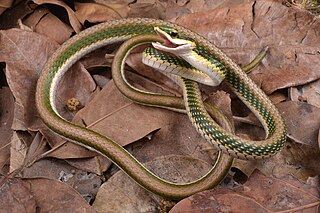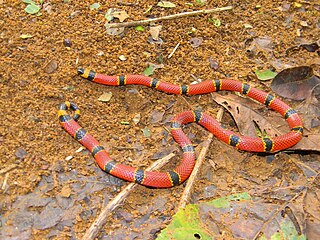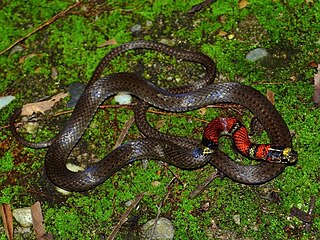
Coral snakes are a large group of elapid snakes that can be divided into two distinct groups, the Old World coral snakes and New World coral snakes. There are 27 species of Old World coral snakes, in three genera, and 83 recognized species of New World coral snakes, in two genera. Genetic studies have found that the most basal lineages have origins in Asia, suggesting that the group originated in the Old World. While new world species of both genera are venomous, their bites are seldom lethal; only two confirmed fatalities have been documented in the past 100 years from the genus Micrurus. Meanwhile, snakes of the genus Micruroides have never caused a medically significant bite.

Micrurus is a genus of venomous coral snakes of the family Elapidae.

André Marie Constant Duméril was a French zoologist. He was professor of anatomy at the Muséum national d'histoire naturelle from 1801 to 1812, when he became professor of herpetology and ichthyology. His son Auguste Duméril was also a zoologist, and the author citation Duméril is used for both André and his son.

Oxyrhopus petolarius, commonly known as the forest flame snake, is a species of mildly venomous snake in the family Colubridae. The species is endemic to South America. There are three recognized subspecies.

Boiga dendrophila, commonly called the mangrove snake or the gold-ringed cat snake, is a species of rear-fanged venomous snake in the family Colubridae. The species is endemic to southeast Asia. It is one of the biggest cat snake species, averaging 8–9 feet in length. It is considered mildly venomous. Although moderate envenomations resulting in intense swelling have been reported, there has never been a confirmed fatality.

Micrurus tener, commonly known as the Texas coral snake, is a species of venomous snake in the family Elapidae. The species is native to the southern United States and adjacent northeastern and central Mexico. Five subspecies are recognized as being valid, including the nominotypical subspecies, Micrurus tener tener, which is found in both the US and Mexico, and is also commonly known as the Texas coral snake. The species Micrurus tener was once considered to be a subspecies of the eastern coral snake.

Micrurus hemprichii, commonly known as Hemprich's coral snake and the worm-eating coral snake, is a species of venomous coral snake in the family Elapidae. The species is native to South America.

Leptophis mexicanus, commonly known as the Mexican parrot snake, is a species of medium-sized slender snake in the family Colubridae. The species is endemic to the Americas.

Ninia sebae, commonly known as the redback coffee snake or the red coffee snake, is a species of small terrestrial snake in the family Colubridae. The species is endemic to Mexico and Central America south to Costa Rica. Although it resembles some venomous coral snakes in color and size, it is not venomous and seldom bites humans.

Micrurus nigrocinctus, commonly known as the Central American coral snake, is a species of a highly venomous snake in the family Elapidae. The species is endemic to Latin America from southern Mexico, Central America, to north Colombia. There are six recognized subspecies, including the nominate subspecies described here.

Micrurus browni, commonly known as Brown's coral snake, is a species of venomous snake in the family Elapidae. The species is native to Guatemala and southwestern Mexico. There are three recognized subspecies, including the nominate subspecies described here.

Oxyrhopus, the false coral snakes, is a genus of colubrid snakes that belong to the subfamily Dipsadinae. The genus is found in Central America and the northern part of South America, and it includes 15 distinct species.

Bogert's coral snake is a species of venomous snake in the family Elapidae. The species is endemic to southern Mexico.

The elegant coral snake is a species of elapid snake, native to southern Mexico and Guatemala. There are two recognized subspecies.

Micrurus mipartitus is a species of coral snake in the family Elapidae. It is found in South and Central America. The redtail coral snake is common in agricultural areas in Colombia. Its highly neurotoxic venom is known to cause seizures in its prey by activating nerve proteins responsible for seizures within it.

Scaphiodontophis annulatus, commonly known as the Guatemala neckband snake, is a species of snake in the family Colubridae. The species is native to southern Mexico, Central America, and Colombia. There are four recognized subspecies.

Pituophis deppei, commonly known as the Mexican bullsnake and the Mexican pine snake, is a species of nonvenomous colubrid snake endemic to Mexico. There are two recognized subspecies.

Xenodon dorbignyi, the South American hognose snake, is a species of snake in the family Colubridae. The species is native to southern South America. There are four recognized subspecies.




















